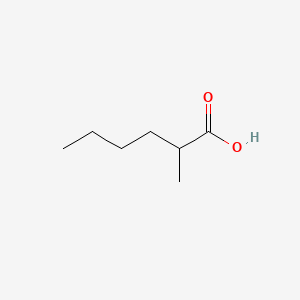| MeSH term | MeSH ID | Detail |
|---|---|---|
| Body Weight | D001835 | 333 associated lipids |
| Congenital Abnormalities | D000013 | 11 associated lipids |
2-METHYLHEXANOIC ACID
2-METHYLHEXANOIC ACID is a lipid of Fatty Acyls (FA) class. 2-methylhexanoic acid is associated with abnormalities such as Little's Disease. The involved functions are known as inhibitors, Synthesis, Recurrence and Translation, Genetic.
Cross Reference
Introduction
To understand associated biological information of 2-METHYLHEXANOIC ACID, we collected biological information of abnormalities, associated pathways, cellular/molecular locations, biological functions, related genes/proteins, lipids and common seen animal/experimental models with organized paragraphs from literatures.
What diseases are associated with 2-METHYLHEXANOIC ACID?
2-METHYLHEXANOIC ACID is suspected in Little's Disease and other diseases in descending order of the highest number of associated sentences.
Related references are mostly published in these journals:
| Disease | Cross reference | Weighted score | Related literature |
|---|
Possible diseases from mapped MeSH terms on references
We collected disease MeSH terms mapped to the references associated with 2-METHYLHEXANOIC ACID
PubChem Associated disorders and diseases
What pathways are associated with 2-METHYLHEXANOIC ACID
There are no associated biomedical information in the current reference collection.
PubChem Biomolecular Interactions and Pathways
Link to PubChem Biomolecular Interactions and PathwaysWhat cellular locations are associated with 2-METHYLHEXANOIC ACID?
There are no associated biomedical information in the current reference collection.
What functions are associated with 2-METHYLHEXANOIC ACID?
Related references are published most in these journals:
| Function | Cross reference | Weighted score | Related literatures |
|---|
What lipids are associated with 2-METHYLHEXANOIC ACID?
There are no associated biomedical information in the current reference collection.
What genes are associated with 2-METHYLHEXANOIC ACID?
There are no associated biomedical information in the current reference collection.
What common seen animal models are associated with 2-METHYLHEXANOIC ACID?
There are no associated biomedical information in the current reference collection.
NCBI Entrez Crosslinks
All references with 2-METHYLHEXANOIC ACID
Download all related citations| Authors | Title | Published | Journal | PubMed Link |
|---|---|---|---|---|
| pmid: | ||||
| Schmuker M et al. | Predicting olfactory receptor neuron responses from odorant structure. | 2007 | Chem Cent J | pmid:17880742 |
| Kumar PA et al. | Identification of fruity aroma-producing compounds from Chryseobacterium sp. isolated from the Western Ghats, India. | 2011 | Curr. Microbiol. | pmid:21667308 |
| Chang P et al. | The antiepileptic drug valproic acid and other medium-chain fatty acids acutely reduce phosphoinositide levels independently of inositol in Dictyostelium. | 2012 | Dis Model Mech | pmid:21876211 |
| Philipsen EK et al. | Gastrointestinal permeability to polyethylene glycol: an evaluation of urinary recovery of an oral load of polyethylene glycol as a parameter of intestinal permeability in man. | 1988 | Eur. J. Clin. Invest. | pmid:3133220 |
| Hyma KE et al. | Divergence in wine characteristics produced by wild and domesticated strains of Saccharomyces cerevisiae. | 2011 | FEMS Yeast Res. | pmid:22093681 |
| Das N et al. | Benzoxazinones as Human Peroxisome Proliferator Activated Receptor Gamma (PPARγ) Agonists: A Docking Study Using Glide. | 2011 | Indian J Pharm Sci | pmid:22303058 |
| Zheng LY et al. | Aroma volatile compounds from two fresh pineapple varieties in China. | 2012 | Int J Mol Sci | pmid:22837701 |
| Ohta K et al. | Separation and conductimetric detection of C1-C7 aliphatic monocarboxylic acids and C1-C7 aliphatic monoamines on unfunctionized polymethacrylate resin columns. | 2004 | J Chromatogr A | pmid:15250420 |
| Kagan M et al. | Normal-phase chiral liquid chromatography-mass spectrometry of non-UV-active compounds: applications for pharmaceutically relevant racemates. | 2006 | J Chromatogr A | pmid:16445925 |
